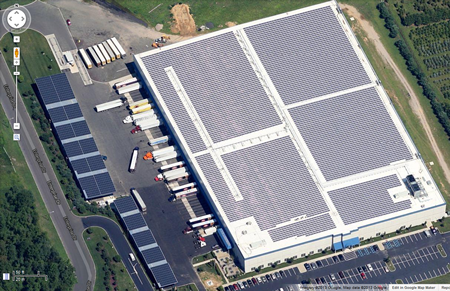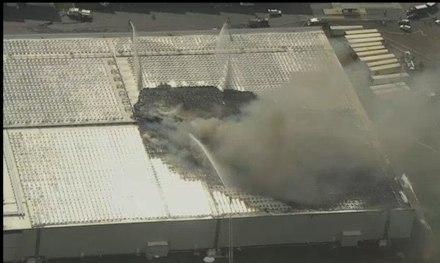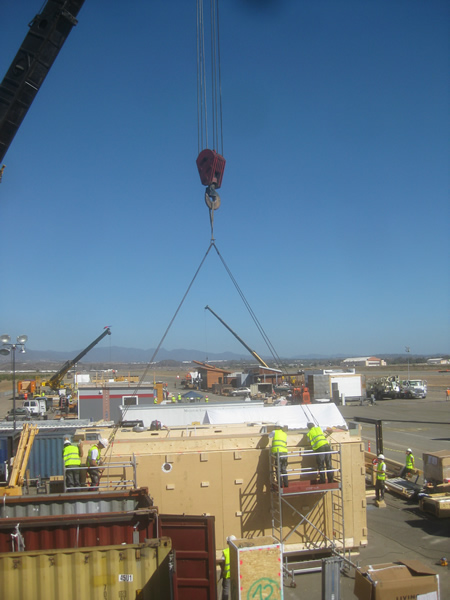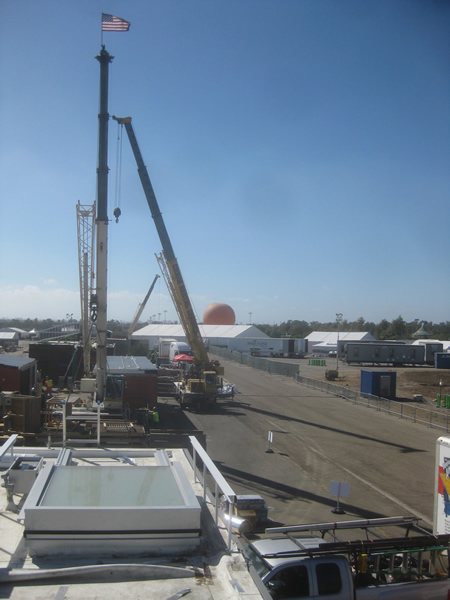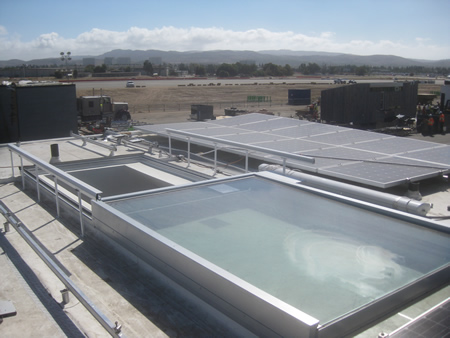Welcome to the
Run on Sun Monthly Newsletter

In this Issue: |
September, 2013
Volume: 4 Issue: 9
Fire! Is Solar a Threat?We saw a piece this month about a fire on a distribution warehouse in New Jersey that was gutted in part because the local fire department was afraid to interact with the solar power system on the warehouse roof. As solar makes greater inroads on commercial buildings, what can we as an industry do to address this concern? (H/T SolarWakeup.com) The distribution center, owned by Dietz & Watson, was a refrigerated warehouse that supported over 7,000 solar modules according to news reports. From Google we get this image of the center in happier days: This image makes clear that the NE quadrant of the building has been extensively damaged - the black area is where the solar panels have been completely destroyed. The image also makes clear that the fire department chose to fight this fire from the ground, spraying water and foam onto the roof as opposed to going on to the roof itself. (There was no explanation given as to the cause of the fire.) The local reporting indicated that the fire crews were concerned about possible collapse of the roof due to the amount of water being poured onto the fire. But they also mentioned the concern over possible electrocution:
So what to make of all of this? There can be no doubt that solar installations have the potential to make the already dangerous business of fighting a fire more hazardous. Strings of solar panels can produce as much as 600 Volts DC and as a general rule, there is no way to shut them off from the ground. While a DC disconnect on the ground could isolate the array from a ground mounted inverter, there is still potential in the conductors leading from the roof to the inverter. If those conductors are shorted together - due to either a fireman's actions or the fire itself - there is the potential for significant arcing and possibly even electrocution. Of course, one way to reduce that risk is through the use of microinverters or AC modules. With a microinverter, the only conductor runs are AC which can be safely switched off from the ground meaning that any conductors coming from the roof to the ground will be safe. The individual solar modules can still produce power, but there are no strings to slice into or suddenly short to create a dangerous condition on the roof. While microinverter systems are not generally considered on systems of this size, Enphase recently announced the use of their products on a 2.3 MW commercial array - possibly larger than this one. Which begs the question - would that have mattered here? Maybe, maybe not. The question really is a function of how well would the local fire department understand the difference? When we talk with local fire inspectors, they are always appreciative of the added safety to be found with microinverter systems but how well does the inspector's understanding extend to the fire crews reporting to that fire? Would they have trusted that the claimed safety was real and moved more aggressively to fight the fire on the roof? Or would they have elected to play it safe? The solar industry can work to develop safer products - which microinverters surely are - but that won't matter if local fire crews aren't educated as to how best to fight these fires. Interestingly, while local codes require solar installers to provide all sorts of largely useless signage on our arrays - for example, specifying the nominal AC voltage and current as if that would make the least bit of difference to anyone - there is no requirement to indicate the type of inverter being used. Absent such signage, how would a local fire crew know what they were facing?
So much of what we must do in the solar industry is education - this appears to be one area where we need to improve our efforts. |
“The solar industry can work to develop safer products—which microinverters surely
are—but that won't matter if local fire crews aren't educated as to how best to fight these fires…”
Get your copy of
Commercial Solar:
Step-by-Step
from
Run on Sun
Founder & CEO
Jim Jenal

Now available on Amazon.com
in both
Print & Kindle versions.
Bonus - Buy the Print version…
Get the
Kindle version for Free!
Commercial Solar:
Step-by-Step
from Run on Sun
Founder & CEO
Jim Jenal

Now available on Amazon.com
in both Print & Kindle versions.
Get the Kindle version for Free!
Help Us Spread the News!





Solar Decathlon Update - Coming TogetherWe spent part of last week with the great group of folks from Team USC working to re-install their solar PV system. Here's our update.
Support Team USCIt is a privilege to be a part of the Solar Decathlon - but for the teams involved it is also a massive fund raising project and success, or failure, can be tied to that aspect as much as a great design. In fact we learned yesterday that one of the teams from Virginia had to drop out of the contest because they couldn't raise enough money to complete their design and then ship it to California. So sad to think that two years worth of hard work went down the drain because they fell short on their fund raising. (As they said in The Right Stuff, "No bucks, no Buck Rogers.") While Team USC has not suffered such a depressing fate, they could still use your support. So if you would be interested in contributing to the team, you can jump over to their Support page and make a donation. A Little Help from Their Friends...Finally, while we were taking a break on the ground, we came across a film team that was documenting the Team's progress and they told us about this video that was shot while we were doing the initial installation. The entire video is well worth watching as it documents the efforts of the four teams from California that are competing this year. But we have to admit, we are partial to the section that begins around the 35 minute mark - and stick around for the happy conclusion after the break! Best of luck to all the schools competing, and especially to Team USC - Fight On! |
Run on Sun Named One of Top Solar ContractorsSolar Power World, which recently quoted Run on Sun Founder & CEO Jim Jenal at length in a news article, has just announced their annual listing of the Top 250 Solar Contractors in the United States and Run on Sun made the list, coming in at number 234.
From Solar Power World's editorial announcing the list:
For a local company like Run on Sun, it is a great honor to be listed among the biggest and best known solar companies in the country. We are proud of our role in building this industry, and proud to be a voice for making the industry live up to its vision. After all, you cannot claim to be part of building a sustainable future if you engage in shoddy business practices or stoop to unsavory marketing tricks. So congrats to all our colleagues who made the list - here's to continuing to grow an industry we all love! |
